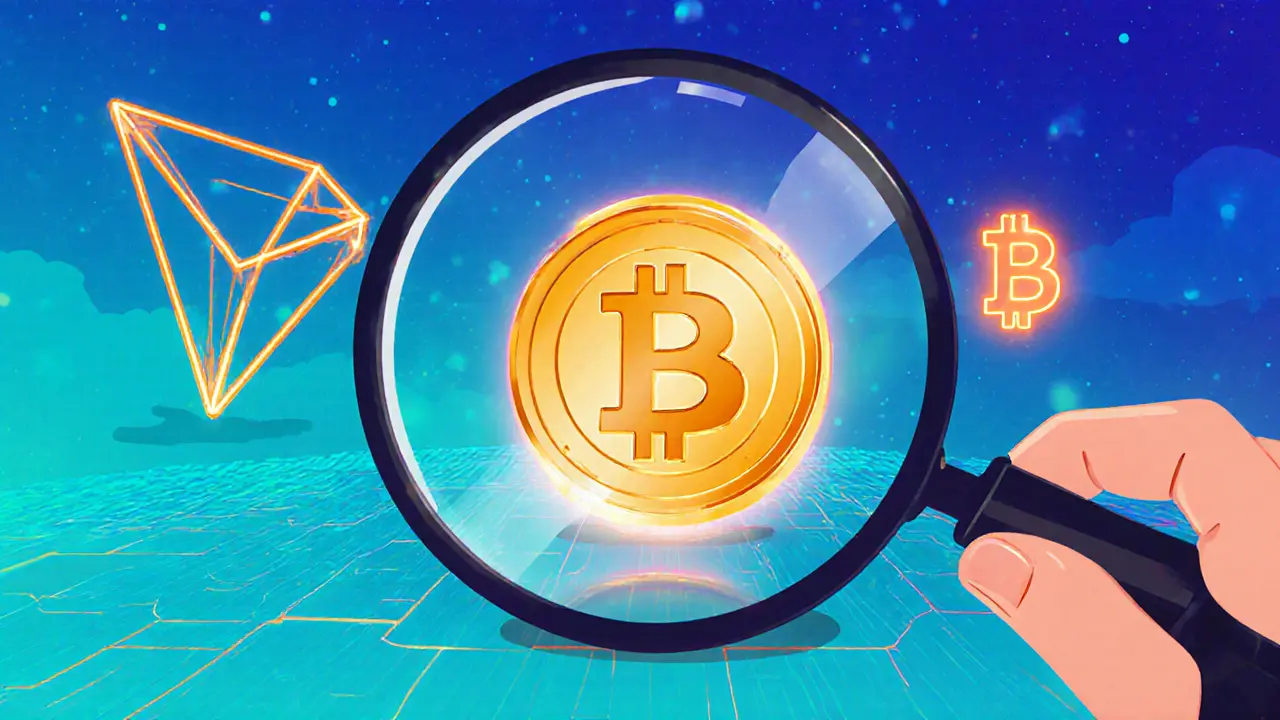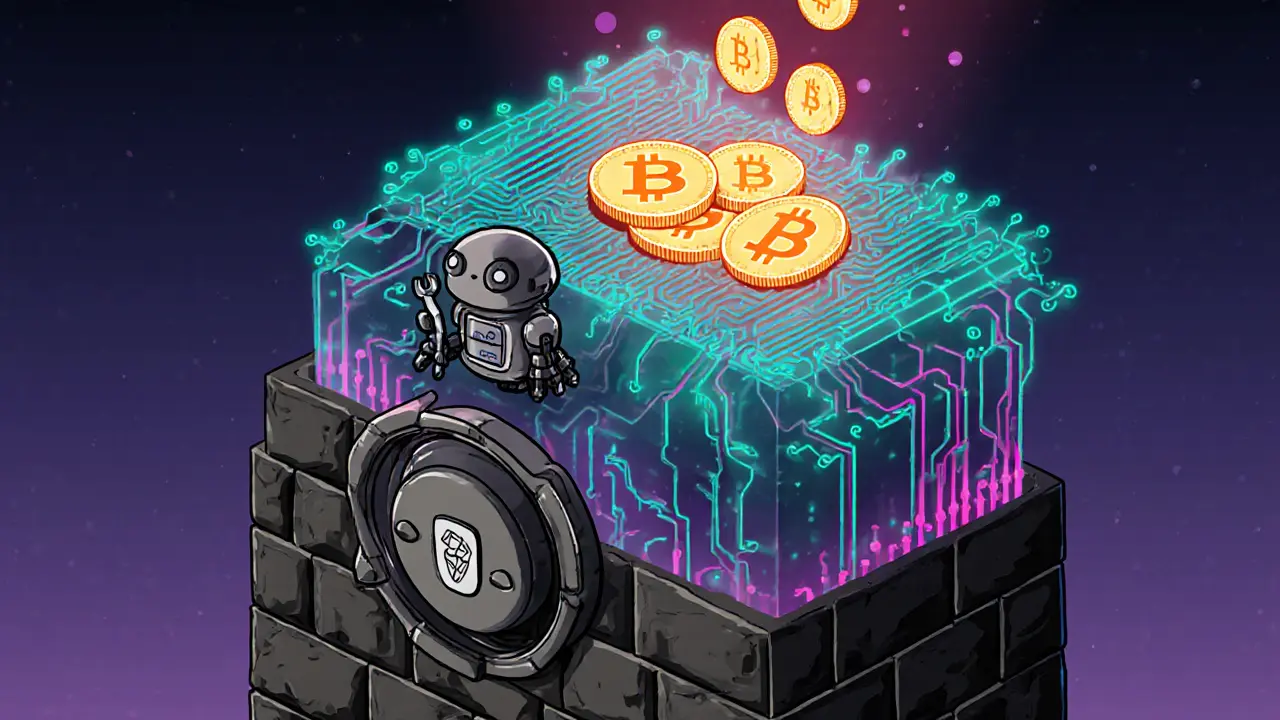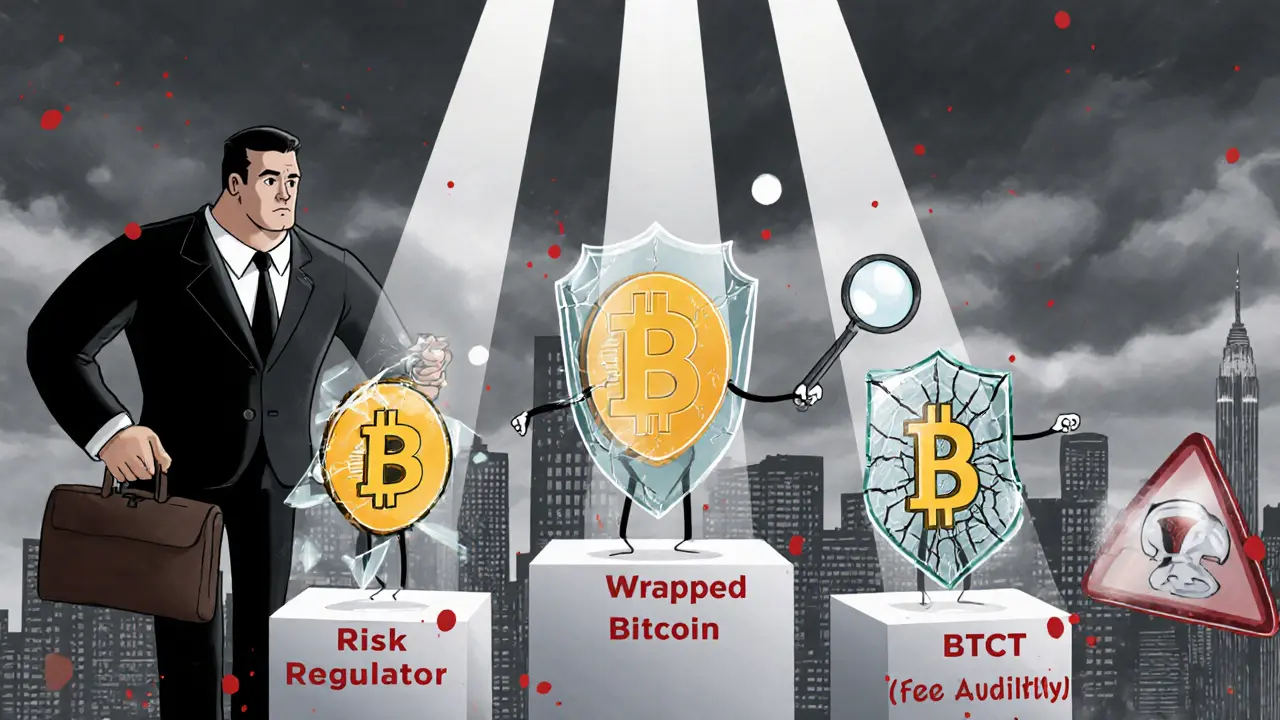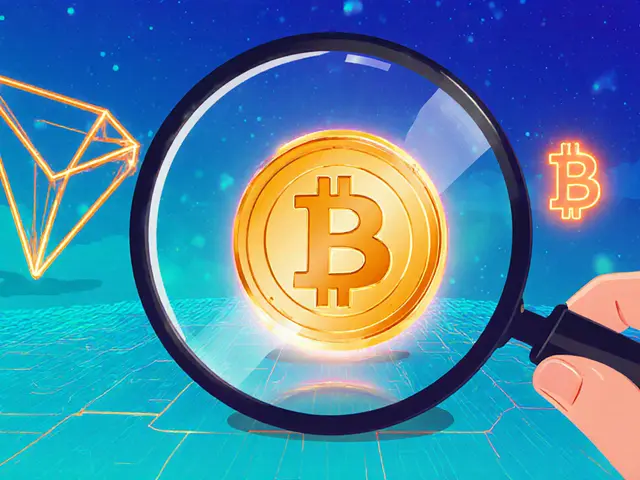Bitcoin TRC20 (BTCT) Explained: How the TRC20 Token Works

Bitcoin TRC20 (BTCT) Calculator
Token Overview
Bitcoin TRC20 (BTCT) is a TRC20-standard token on the Tron network claiming to be fully collateralized by Bitcoin. This calculator helps estimate the token's value and assess associated risks.
Token Parameters
Estimated Results
* Based on current market data and token parameters
* Risk level considers custodial risk, liquidity, and regulatory factors
Risk Assessment
- Custodial Risk High
- Liquidity Risk Medium
- Regulatory Risk Medium
- Smart Contract Risk High
- Network Risk Low
By October 2025 the crypto market has more than a dozen ways to gain exposure to Bitcoin without actually holding the original coin. One of the most eye‑catching entries is a token that lives on the Tron blockchain and claims a 1‑to‑1 backing by Bitcoin. Yet the token’s structure, risk profile, and real‑world usage are rarely explained in plain English.
Below you’ll find a step‑by‑step breakdown of what Bitcoin TRC20 really is, how it differs from native Bitcoin and other wrapped assets, where you can buy it, and what red flags to watch.
Bitcoin TRC20 is a TRC20‑standard token on the Tron network that claims to be fully collateralised by Bitcoin (BTC). The project publishes reserve addresses that are meant to be auditable, but independent proof‑of‑reserves has not been publicly verified.
What makes a TRC20 token different?
The Tron blockchain uses its own native token, TRX, to pay for transaction fees. TRC20 is the protocol that defines how fungible tokens behave on Tron - similar to ERC‑20 on Ethereum. Because TRC20 supports smart contracts, developers can create tokens that automatically enforce rules, such as pegging to another asset.
Tron network offers fast block times (≈3 seconds) and near‑zero fees, which is why many wrapped‑BTC projects prefer it over slower, pricier chains.
How Bitcoin TRC20 claims to be backed by Bitcoin
The token’s whitepaper states that every BTCT is backed 100% by a Bitcoin held in a cold‑storage reserve. The reserve address is published on the project’s site, and anyone can view the BTC balance on a block explorer. In theory, this creates a simple one‑to‑one peg: trade one BTCT, receive one BTC on redemption.
In practice, the crucial step is a trustworthy custodian that actually holds the Bitcoin. Independent audits have not confirmed the existence of those reserves, and analysts at ExponentialDeFi label the token as “a large‑cap asset with questionable collateral reserves.”
Technical architecture: proof‑of‑work timestamping and smart contracts
Bitcoin TRC20 combines two layers. The underlying Bitcoin blockchain provides proof‑of‑work security, while Tron’s smart contracts manage token issuance and transfers. When a user deposits BTC to the reserve address, the project’s custodial system mints an equal amount of BTCT on Tron. Conversely, redeeming BTCT burns the token and releases the corresponding BTC.
This hybrid model means users pay transaction fees in TRX, not Bitcoin, and benefit from Tron’s sub‑cent fees. However, it also adds a dependency on the custodian's operational integrity.

Supply, market data, and trading activity
According to CoinMarketCap (2025), BTCT has a fixed total supply of 25,000 tokens. The circulating supply matches the total supply, giving each token a massive implied price per Bitcoin. Market capitalization sits at roughly $3.04billion, while the fully diluted valuation (FDV) reaches $2.55trillion because the market assumes the token will always be 1:1 with Bitcoin.
Despite the headline numbers, 24‑hour trading volume is modest - about $105k, a 180% spike that still represents less than 0.004% of market cap. Low liquidity can cause slippage and price manipulation, especially on smaller decentralized exchanges.
How to acquire and store BTCT
Acquiring BTCT follows the standard TRC20 workflow:
- Set up a Tron‑compatible wallet (e.g., TronLink, Trust Wallet, or a hardware wallet with Tron support).
- Buy TRX to cover transaction fees.
- Swap TRX or other TRC20 tokens for BTCT on a decentralized exchange (DEX) like JustSwap or on a centralized exchange that lists the token (Binance, KuCoin, OKX, etc.).
- Verify the token contract address - the official BTCT contract is
TCx... (replace with actual address)- to avoid phishing tokens. - Keep the token in your wallet; you can also stake it on certain platforms that offer yield farming, but staking adds smart‑contract risk.
When moving BTCT, you’ll pay a few micro‑TRX as gas, typically a few cents at current network rates.
Risk checklist for BTCT investors
- Custodial risk: The Bitcoin backing relies on a single entity that has not provided verifiable proof‑of‑reserves.
- Liquidity risk: Thin order books mean large trades can move the price dramatically.
- Regulatory risk: Wrapped tokens are under growing scrutiny; a regulator could demand proof‑of‑reserves or force delisting.
- Smart‑contract risk: Bugs in the TRC20 contract could freeze or burn tokens.
- Network risk: Tron’s reputation and future development trajectory affect BTCT’s long‑term viability.

Comparing BTCT with other Bitcoin‑backed tokens
| Token | Primary Chain | Backing Mechanism | Custody Model | Typical Fee (Transfer) |
|---|---|---|---|---|
| BTC | Bitcoin | Native | Decentralised network | ~0.00001BTC (≈$0.30) |
| WBTC | Ethereum (ERC‑20) | 100% Bitcoin reserves | Multi‑signature custodians (BitGo, etc.) | ~$2 (gas) |
| BTCT | Tron (TRC20) | Claims 100% Bitcoin reserves | Single‑entity custodian (unverified) | ~$0.01 (TRX gas) |
The Bitcoin TRC20 token shines in fee‑efficiency, but its custodial opacity puts it behind WBTC and native BTC on the trust factor.
Future outlook and regulatory environment
Industry trends point toward tighter audits for any token that claims to be fully collateralised. If BTCT’s team publishes a verifiable proof‑of‑reserves (e.g., using Merkle proofs or third‑party attestations), the token could regain credibility and attract more institutional interest.
Conversely, failure to meet these expectations may trigger delistings from major exchanges, especially as regulators in the U.S., EU, and Asia tighten reporting requirements for wrapped assets. Keeping an eye on official announcements and audit reports is essential for anyone holding BTCT.
Quick reference checklist
- Token name: Bitcoin TRC20 (BTCT)
- Chain: Tron, TRC20 standard
- Total supply: 25,000 BTCT
- Backing claim: 1BTC per BTCT
- Key risk: No independent proof‑of‑reserves
- Where to store: Tron‑compatible wallet (TronLink, Trust Wallet, Ledger + Tron app)
- Typical fee: A few micro‑TRX per transaction
Frequently Asked Questions
Is BTCT truly 1:1 backed by Bitcoin?
The project states that each token is backed by a Bitcoin held in a reserve address, but independent audits have not confirmed the holdings. Investors should treat the claim as unverified until third‑party proof is released.
How does BTCT differ from Wrapped Bitcoin (WBTC)?
WBTC lives on Ethereum, uses a multi‑signature custodial model, and publishes regular audits. BTCT operates on Tron, offers cheaper fees, but currently relies on a single custodian with no public audit.
Can I redeem BTCT for actual Bitcoin?
The protocol includes a redemption function, but it requires using the official custodial service. Without verified reserves, redemption could be delayed or impossible.
What wallets support BTCT?
Any wallet that supports TRC20 tokens works - popular choices are TronLink (browser extension), Trust Wallet (mobile), and Ledger hardware wallets with the Tron app installed.
Is BTCT a good long‑term investment?
Its appeal lies in low fees and fast transfers, but the lack of transparent backing makes it riskier than native Bitcoin or audited wrapped tokens. Consider it speculative and limit exposure.

manika nathaemploy
I get why people are drawn to BTCT – cheap fees are sweet. Still, the lack of audit makes me uneasy.
EDWARD SAKTI PUTRA
The TRC20 approach is clever, leveraging Tron’s speed while trying to mirror Bitcoin. But without transparent reserves, the peg feels fragile. Investors should keep a close eye on any audit releases.
Brian Lisk
Bitcoin TRC20 (BTCT) certainly rides on the promise of ultra‑low fees, but the promise of a 1:1 Bitcoin reserve is only as solid as the custodian’s honesty. The whitepaper claims a cold‑storage address, yet no third‑party audit has ever signed off on the balance, leaving a glaring trust gap. When you compare it to Wrapped Bitcoin (WBTC), the latter publishes monthly attestations from reputable custodians like BitGo, which adds a layer of legitimacy. BTCT’s reliance on a single, opaque entity makes any redemption process potentially opaque and risky. Moreover, the token’s total supply of just 25,000 units inflates the implied per‑token value, but also amplifies price volatility when even modest trades occur. Liquidity on JustSwap and other DEXs remains thin; a 0.5 BTC‑sized order could swing the price by several percent. On the regulatory front, many jurisdictions are tightening scrutiny on wrapped assets, demanding proof‑of‑reserves to protect retail investors. If BTCT fails to deliver such proof, exchanges may delist it, further draining liquidity. The smart‑contract layer on Tron is efficient, but it adds another attack surface; any bug could freeze or burn tokens. Users also need to hold TRX for gas, which is cheap today but could spike under network congestion. For long‑term holders, the biggest question is governance: who decides on upgrades, and can the community intervene if the custodian misbehaves? In short, the low‑fee advantage is real, but the custodial opacity and regulatory uncertainty make BTCT a high‑risk speculative play. If you’re comfortable with that risk profile, a small exposure might be acceptable, but treating it as a safe Bitcoin proxy would be naïve.
Melanie LeBlanc
Totally get where you’re coming from – the cheap TRX fees are a real plus. Still, it’s wise to keep a healthy skepticism about the backing until we see an independent audit.
Jasmine Kate
Oh please, another “secret” reserve that no one can verify – classic drama from a token that loves the hype train. The whole 1:1 claim is just marketing fluff, and anyone buying at these “low fees” is basically handing over their cash to a mystery custodian.
Franceska Willis
i think the biggest red flag is the missing proof‑of‑reserves – its like buying a car without ever seeing the engine. also, watch out for phishing contracts that look just like the real BTCT address.
Darren Belisle
Honestly, the concept is fascinating, and the speed of Tron is a genuine advantage; however, we must weigh the custodial risk, the thin order books, and the regulatory landscape, all of which could dramatically affect BTCT’s future. Let’s stay optimistic but vigilant!
Mark Bosky
From a formal perspective, the token’s underlying architecture is sound, yet the absence of verifiable reserves constitutes a material risk; prospective investors should demand transparent audits before allocating capital.
Jack Stiles
just look at the fees – they’re basically pennies. but yeah, the custodian thing is kinda sketchy, so dont go all in.
Ritu Srivastava
It’s morally questionable to market a token as fully collateralized while refusing to provide any verifiable evidence. Investors deserve honesty, not speculative smoke and mirrors.
Liam Wells
One must consider, with utmost seriousness, the possibility that the custodian’s claims are unfounded; the token’s volatility, compounded by low liquidity, could precipitate a catastrophic loss for uninformed participants, thereby necessitating rigorous due diligence before any engagement.
Caleb Shepherd
Everyone’s forgetting that the whole "wrapped" ecosystem is a front for the elite to hoard control; BTCT is just another pawn in that game, and the lack of audits is a deliberate move to keep the masses in the dark.
Heather Zappella
For those looking to diversify exposure to Bitcoin, BTCT offers an interesting fee profile, but the community should prioritize a third‑party audit to validate the reserve claims. This would align with best practices seen in other wrapped assets.
Kate O'Brien
There’s a lot of talk about "trust" but no one’s actually checking the numbers. It feels like a blind leap of faith.
Ricky Xibey
Nice look at the fees, but watch out for the custodial risk – it’s a real thing.
Caitlin Eliason
Seriously, this is a red‑flag fiesta! 🔥
Don Price
Let’s entertain the possibility that the “transparent reserve” is a cleverly disguised liquidity trap, engineered by unseen hands to siphon funds under the guise of decentralization; think about the historical patterns of crypto projects where the lack of third‑party verification preceded massive wipe‑outs, and you’ll see why skepticism is warranted. The intrigue deepens when regulators start poking around, potentially forcing a sudden audit that could expose a shortfall, leading to a cascade of sell‑offs across low‑volume exchanges. In short, the hype sells the idea, but the reality may be a house of cards ready to tumble.
Dawn van der Helm
Hope we can keep the conversation kind and constructive 🌱 – transparency will help everyone feel safer.
Monafo Janssen
Totally agree, having a clear audit would make a world of difference for new users. It’s like waiting for the lights to turn green before you cross the street – better safe than sorry.
Michael Phillips
From a philosophical standpoint, the trust model of wrapped assets raises questions about decentralization itself; if a single custodian can unilaterally control the backing, then the token’s claim to be a true “Bitcoin proxy” is philosophically inconsistent.